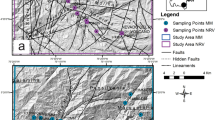Abstract
The stability of shale gas wells drilled through current and future coal reserves can be compromised by ground deformations due to nearby longwall mining. Depending on the longwall-induced rockmass permeability, the high-pressure explosive gas from the damaged well may reach mine workings and overwhelm the mine ventilation systems. This study uses geomechanical models to estimate the rockmass permeability induced by mining. A two-panel longwall model of a deep, 341-m-cover mining site in southwestern Pennsylvania is constructed in 3DEC to explicitly model the rockmass by a discrete fracture network (DFN) technique. Stress-induced fracture apertures and permeabilities are calculated across the model and are validated against permeability measurements. A fracture flow code (FFC) is developed to use these results to predict potential inflow to the mine should a gas well breach occur. One hundred DFN realizations are simulated, and the results show that for a gas pressure of 2.4 MPa, the average of the predicted inflow rates to this deep-cover mine is 0.006 m3/s, significantly lower than the average inflow of 0.22 m3/s for a shallow-cover mine (145-m deep) studied in the previous work (Khademian, et al. 2021). The result can help assess the potential hazards of a shale gas well breach for mine safety and evaluate the ventilation requirements to mitigate the risk.








Similar content being viewed by others
References
Ajayi KM, Khademian Z, Schatzel SJ, Watkins E, & Gangrade V (2021) Numerical modeling of longwall-induced permeability under shallow cover. In Tukkaraja (Ed.), Mine Ventilation (pp. 389–397): CRC Press.
Esterhuizen GS, Mark C, and Murphy MM (2010) Numerical model calibration for simulating coal pillars, gob and overburden response. In proceeding of the 29th International Conference on Ground Control in Mining. Morgantown, WV: Barczak T, ed. 46–57
Feng G, Li Z, Hu S, Zhang Y, Zhang A, Gao Q, Cui J (2018) Distribution of gob empty space for methane drainage during the longwall mining: A case study. J Nat Gas Sci Eng 60:112–124. https://doi.org/10.1016/j.jngse.2018.09.026
Khademian Z, Ajayi KM, Su DWH, Esterhuizen G, and Schatzel SJ (2021) Geomechanical modeling of mining-induced permeability: implications for potential gas inflow from a sheared gas well. the 40th International Conference on Ground Control in Mining, Morgantown, WV.
Kohl WR (1980) Jointing in outcropping rocks of Pennsylvanian age, central Greater Pittsburgh region, Pennsylvania. U.S. Geological Survey, 80–23. https://doi.org/10.3133/ofr8023.
Mark C, Agioutantis Z (2019) Analysis of coal pillar stability (ACPS): a new generation of pillar design software. Int J Min Sci Technol 29:87–91
PADEP (2018). 2018 Oil and Gas Annual Report. Pennsylvania Department of Environmental Protection.
Palchik, V. (2003). Formation of fractured zones in overburden due to longwall mining. Environ Geol 44:(1) 28–38. https://doi.org/10.1007/s00254-002-0732-7
Pappas DM, and Mark C (1993). Behavior of Simulated Gob Material. U.S. Department of the Interior, Bureau of Mines, Report of Investigations 9458, 1993:1–39
Salamon MDG (1990). Mechanism of caving in longwall coal mining. Paper presented at the Rock Mechanics Contributions and Challenges: Proceedings of the 31st U.S. Symposium. https://doi.org/10.1201/9781003078944-26
Van Dyke MA, Zhang, P, Dougherty H, Su D, & Kim BH (2022) Identifying Longwall-Induced Fracture Zone Height Through Core Drilling. Mining, Metallurgy & Exploration. https://doi.org/10.1007/s42461-022-00622-z
Zhang P, Su D, Dougherty H, Kimutis R, Schatzel S, & Lu J (2020) A Case Study on Longwall Mining Near Shale Gas Wells in Barrier Pillars – Influence, Safety, and Risks. In the proceeding of the 54th U.S. Rock Mechanics/Geomechanics Symposium.
Zhang P, Dougherty H, Su DWH, Trackemas J, Tulu B (2020) Influence of longwall mining on the stability of gas wells in chain pillars. Int J Min Sci Technol 30(1):3–9
Acknowledgements
Data from this manuscript have been presented at the MINEXCHANGE 2022 SME Annual Conference & Expo, February 27–March 2, 2022, Salt Lake City, UT.
Author information
Authors and Affiliations
Corresponding author
Ethics declarations
Conflict of interest
The authors declare no competing interests.
Disclaimer
The findings and conclusions in this report are those of the author(s) and do not necessarily represent the official position of the National Institute for Occupational Safety and Health, Centers for Disease Control and Prevention (CDC). Mention of any company or product does not constitute endorsement by NIOSH.
Additional information
Publisher's note
Springer Nature remains neutral with regard to jurisdictional claims in published maps and institutional affiliations.
Rights and permissions
About this article
Cite this article
Khademian, Z., Ajayi, K.M., Schatzel, S.J. et al. Rockmass Permeability Induced by Longwall Mining Under Deep Cover: Potential Gas Inflow from a Sheared Gas Well. Mining, Metallurgy & Exploration 39, 1465–1473 (2022). https://doi.org/10.1007/s42461-022-00635-8
Received:
Accepted:
Published:
Issue Date:
DOI: https://doi.org/10.1007/s42461-022-00635-8




